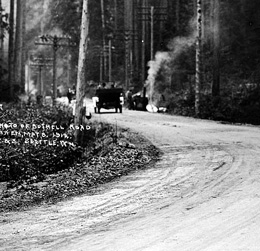On March 13, 1905, Washington Governor Albert E. Mead (1863-1913) signs House Substitute Bill No. 25, creating the Office of Highway Commissioner and a State Highway Board. The Commissioner and Board are to work with county commissioners to construct state roads designated by the Legislature. The legislation makes Washington the 14th state to establish a highway department.
Winding Road to a State Highway Department
Teamsters, farmers, bicyclists, and a few pioneering automobile drivers, organized by visionary Sam Hill (1857-1931) into the Washington State Good Roads Association, had been lobbying for years for a state highway department to improve and expand the state's highways. At the time, there were fewer than 1,000 miles of state roads and most of those were unpaved.
In 1903, the Good Roads enthusiasts convinced the Legislature to pass House Substitute Bill No. 30, "Providing for the Establishment and Repair of Certain State Roads." The bill designated the routes of 10 State Roads and appropriated $100,000 for their construction. It also created a Highway Commissioner and Highway Board and appropriated $10,000 for the commissioner's office.
However, on March 21, 1903, Governor Henry McBride vetoed the road bill and various other appropriations which together totaled $399,960.12, pointing out that the Legislature had appropriated more than $2,800,000 while providing only around $2,200,000 in tax revenues. The governor stated:
"Money in the building of state roads and in other directions could be used to the advantage of the public, did our revenues permit. But if the state is not to be burdened with a constantly increasing indebtedness our expenses must be limited to our actual necessities until such time as the legislature, in its wisdom, sees fit to subject to taxation property now escaping taxation altogether, or assessed at only a small fractional part of its value ... . Solely upon the ground that our financial condition will not justify it, I am compelled to disapprove house substitute bill No. 30" (Seattle Post-Intelligencer)
Veto Override
In the 1904 election, Governor McBride was succeeded by fellow Republican Albert Mead. When the Legislature convened in January 1905, large majorities in the House and Senate voted to override the former governor's veto of the road bill. (They also overrode many of his other vetoes). Only Senators Edward B. Palmer of Seattle and Walter Christian of Tacoma voted to sustain the road veto. Christian argued that the bill title was inadequate because it did not reflect that the legislation created the office of Highway Commissioner, and could therefore open the entire appropriation to legal attack.
Although a decision by Assistant Attorney General A. J. Faulkner asserted that the title was sufficient, the Legislature apparently had second thoughts. In early March it passed another bill (the one approved by Governor Mead on March 13) whose title specifically mentioned creation of the highway commissioner's office. The new bill repealed all of the first measure except for the section designating and appropriating money for 10 State Roads. It also added two additional roads to the original 10 designated in the 1903 bill, so that the new highway department began life charged with constructing 12 separate highways.
At first, progress was slow. The initial appropriation and limited authority granted the Highway Commissioner and Board were far from sufficient to build the 12 designated routes, let alone an entire state highway network. However, over the ensuing years and decades, the highway department was granted greater authority over road construction and maintenance and a steadily increasing share of state funds. The start of federal road aid in 1916 and the first state gas tax in 1921 helped the highway department keep pace as the number of automobile owners in the state rose steadily.

